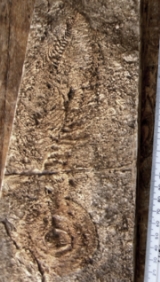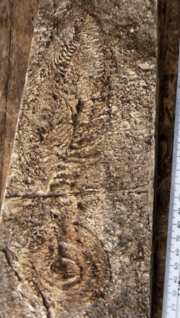
Ediacaran type preservation
Encyclopedia
Ediacaran type preservation relates to the dominant preservational mode in the Ediacaran period, where Ediacaran organisms
were preserved as casts on the surface of microbial mat
s.
 All but the smallest fraction of the fossil record consists of the robust skeletal
All but the smallest fraction of the fossil record consists of the robust skeletal
matter of decayed corpses. Hence, since Ediacaran biota had soft bodies and no skeletons, their abundant preservation is surprising. The absence of burrowing creatures living in the sediments undoubtedly helped; since after the evolution of these organisms in the Cambrian, soft-bodied impressions were usually disturbed
before they could fossilize.
s are areas of sediment stabilised by the presence of colonies of microbes, which secrete sticky fluids or otherwise bind the sediment particles. They appear to migrate upwards when covered by a thin layer of sediment, but this is an illusion caused by the colony's growth; individuals do not, themselves, move. If too thick a layer of sediment is deposited before they can grow or reproduce through it, parts of the colony will die, leaving behind fossils with a characteristically wrinkled "elephant skin" texture.
Most Ediacaran strata with the "elephant skin" texture characteristic of microbial mats contain fossils, and Ediacaran fossils are almost never found in beds that do not contain these microbial mats.
Although microbial mats were once widespread, the evolution of grazing organisms in the Cambrian vastly reduced their numbers, and these communities are now limited to inhospitable refugia
where predators cannot survive long enough to eat them.
, or Solnhofen Limestone
) the Ediacara biota is not found in a restricted environment subject to unusual local conditions: they were a global phenomenon. The processes that were operating must have been systemic and worldwide. There was something very different about the Ediacaran Period that permitted these delicate creatures to be left behind. It is thought that the fossils were preserved by virtue of rapid covering by ash or sand, trapping them against the mud or microbial mats on which they lived. Ash beds provide more detail, and can readily be precisely dated to the nearest million years or better by means of radiometric dating
.
However, it is more common to find Ediacaran fossils under sandy beds deposited by storms or high-energy, bottom-scraping ocean currents known as turbidite
s. Soft-bodied organisms today almost never fossilise during such events, but the presence of widespread microbial mats probably aided preservation by stabilising their impressions in the sediment below.
Conversely, quilted fossils tend to decompose after the cementation of the overlying sediment; hence their upper surfaces are preserved. Their more resistant nature is reflected in the fact that in rare occasions, quilted fossils are found within storm beds, the high-energy sedimentation not having destroyed them as it would have the less-resistant discs. Further, in some cases, the bacteria
l precipitation
of minerals formed a "death mask", creating a mould of the organism.
Ediacara biota
The Ediacara biota consisted of enigmatic tubular and frond-shaped, mostly sessile organisms which lived during the Ediacaran Period . Trace fossils of these organisms have been found worldwide, and represent the earliest known complex multicellular organisms.Simple multicellular organisms such as...
were preserved as casts on the surface of microbial mat
Microbial mat
A microbial mat is a multi-layered sheet of micro-organisms, mainly bacteria and archaea. Microbial mats grow at interfaces between different types of material, mostly on submerged or moist surfaces but a few survive in deserts. They colonize environments ranging in temperature from –40°C to +120°C...
s.
Exceptional preservation

Skeleton
The skeleton is the body part that forms the supporting structure of an organism. There are two different skeletal types: the exoskeleton, which is the stable outer shell of an organism, and the endoskeleton, which forms the support structure inside the body.In a figurative sense, skeleton can...
matter of decayed corpses. Hence, since Ediacaran biota had soft bodies and no skeletons, their abundant preservation is surprising. The absence of burrowing creatures living in the sediments undoubtedly helped; since after the evolution of these organisms in the Cambrian, soft-bodied impressions were usually disturbed
Bioturbation
In oceanography, limnology, pedology, geology , and archaeology, bioturbation is the displacement and mixing of sediment particles and solutes by fauna or flora . The mediators of bioturbation are typically annelid worms , bivalves In oceanography, limnology, pedology, geology (especially...
before they could fossilize.
Microbial mats
Microbial matMicrobial mat
A microbial mat is a multi-layered sheet of micro-organisms, mainly bacteria and archaea. Microbial mats grow at interfaces between different types of material, mostly on submerged or moist surfaces but a few survive in deserts. They colonize environments ranging in temperature from –40°C to +120°C...
s are areas of sediment stabilised by the presence of colonies of microbes, which secrete sticky fluids or otherwise bind the sediment particles. They appear to migrate upwards when covered by a thin layer of sediment, but this is an illusion caused by the colony's growth; individuals do not, themselves, move. If too thick a layer of sediment is deposited before they can grow or reproduce through it, parts of the colony will die, leaving behind fossils with a characteristically wrinkled "elephant skin" texture.
Most Ediacaran strata with the "elephant skin" texture characteristic of microbial mats contain fossils, and Ediacaran fossils are almost never found in beds that do not contain these microbial mats.
Although microbial mats were once widespread, the evolution of grazing organisms in the Cambrian vastly reduced their numbers, and these communities are now limited to inhospitable refugia
Refugia
In biology a refugium , sometimes termed simply a refuge, is a location of an isolated or relict population of a once more widespread species. This isolation can be due to climatic changes, geography, or human activities such as deforestation and over-hunting...
where predators cannot survive long enough to eat them.
Fossilisation
The preservation of these fossils is one of their great fascinations to science. As soft-bodied organisms, they would normally not fossilise. Unlike later soft-bodied fossil biota (such as the Burgess ShaleBurgess Shale
The Burgess Shale Formation, located in the Canadian Rockies of British Columbia, is one of the world's most celebrated fossil fields, and the best of its kind. It is famous for the exceptional preservation of the soft parts of its fossils...
, or Solnhofen Limestone
Solnhofen limestone
The Solnhofen Plattenkalk is a Jurassic Konservat-Lagerstätte that preserves a rare assemblage of fossilized organisms, including highly detailed imprints of soft bodied organisms such as sea jellies...
) the Ediacara biota is not found in a restricted environment subject to unusual local conditions: they were a global phenomenon. The processes that were operating must have been systemic and worldwide. There was something very different about the Ediacaran Period that permitted these delicate creatures to be left behind. It is thought that the fossils were preserved by virtue of rapid covering by ash or sand, trapping them against the mud or microbial mats on which they lived. Ash beds provide more detail, and can readily be precisely dated to the nearest million years or better by means of radiometric dating
Radiometric dating
Radiometric dating is a technique used to date materials such as rocks, usually based on a comparison between the observed abundance of a naturally occurring radioactive isotope and its decay products, using known decay rates...
.
However, it is more common to find Ediacaran fossils under sandy beds deposited by storms or high-energy, bottom-scraping ocean currents known as turbidite
Turbidite
Turbidite geological formations have their origins in turbidity current deposits, which are deposits from a form of underwater avalanche that are responsible for distributing vast amounts of clastic sediment into the deep ocean.-The ideal turbidite sequence:...
s. Soft-bodied organisms today almost never fossilise during such events, but the presence of widespread microbial mats probably aided preservation by stabilising their impressions in the sediment below.
What is preserved?
The rate of cementation of the overlying substrate, relative to the rate of decomposition of the organism, determines whether the top or bottom surface of an organism is preserved. Most disc-shaped fossils decomposed before the overlying sediment was cemented, and the ash or sand slumped in to fill the void, leaving a cast of the underside of the organism.Conversely, quilted fossils tend to decompose after the cementation of the overlying sediment; hence their upper surfaces are preserved. Their more resistant nature is reflected in the fact that in rare occasions, quilted fossils are found within storm beds, the high-energy sedimentation not having destroyed them as it would have the less-resistant discs. Further, in some cases, the bacteria
Bacteria
Bacteria are a large domain of prokaryotic microorganisms. Typically a few micrometres in length, bacteria have a wide range of shapes, ranging from spheres to rods and spirals...
l precipitation
Precipitation (chemistry)
Precipitation is the formation of a solid in a solution or inside anothersolid during a chemical reaction or by diffusion in a solid. When the reaction occurs in a liquid, the solid formed is called the precipitate, or when compacted by a centrifuge, a pellet. The liquid remaining above the solid...
of minerals formed a "death mask", creating a mould of the organism.
Types of preservation
Four different preservational modes are known:- Flinders-style: Such as found in Ediacara, the fossils are preserved on the underside of usually coarse grained sandstone beds;
- Conception-style: The fossils are preserved as an impression in an overlying bed of freshly fallen volcanic ash, often in exquisitely fine detail;
- Nama-style: Fossils are preserved in three dimensions, within fine-grained beds that were deposited in single storm or mudflow events;
- Fermeuse-style: Known from deep water only. Only trace fossils and imprints of holdfast structures are preserved; the soft tissue itself has decayed (although the sediment within the holdfasts remains).

